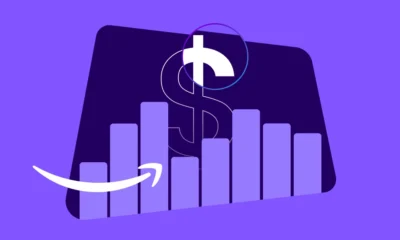PPC
How to Craft Compelling Google Ads for eCommerce

Many of those involved in PPC tend to be the data geeks. That means we often focus more on impression share ratios, target ROAS, and search queries than the creative side of advertising. With Google doing more and more of the heavy data lifting, marketers need to understand that the two things AI and machine learning struggles to replicate are creativity, and a deep understanding of our customers.
High CTRs, alongside highly relevant ad copy, are rewarded with higher quality scores which leading to lower cost per clicks. Lower CPCs are ever more important as the barrier to entry to setting up an ecommerce business is the lowest it’s ever been (and getting lower), especially with the rise of Shopify.
To stand out from the crowd, you need to present a real, tangible differentiation in the market place. Which means you need to be creative with your copy.
Media buyers will often talk about selling points and how you have to showcase your benefits within the ad copy. Ecommerce PPC has 3 core ad copy pillars that the sale hinges on:
1. Your Site
2. Your Product
3. Your Offers
The below highlights some examples in more detail:
Ecommerce Site Selling Points
- Free Delivery Over X: This is a strong incentive for customers to increase their basket size.
- Over 300 5-Star Reviews: Having over 300 5-star reviews demonstrates that you are trusted and have a proven track record of looking after your customers.
- Exclusive To Us: Offering products exclusive to one’s site can create a sense of uniqueness and urgency
- Each Order Donates £1 To Charity: Incorporating charity into each order by donating a fixed amount portrays the brand as socially responsible. This can resonate well with socially conscious consumers.
- Secure Payment: Security in payment processes reassures customers against fraud, leading to increased conversions.
- Fast & Free 2 Day Delivery: Fast and free 2-day delivery appeals to the immediate gratification desire of shoppers.
- 30 Day No Hassle Returns: A 30-day no-hassle return policy reduces the perceived risk of purchasing and encourages trying out new products.
Product Selling Points
- UK Made: Products made in the UK appeal to a sense of national pride and suggest a certain quality
- 31% More Powerful / Finished in 10 Minutes: An item being 31% more powerful or promising completion of tasks in 10 minutes conveys efficiency and value.
- As Seen in Vogue, Cosmopolitan: Having products featured in reputable magazines like Vogue or Cosmopolitan can significantly bolster brand prestige. Where have you have been featured? Can you lean on this angle?
- Made With Bamboo, Cotton, Sustainable / Recyclable: Products made with sustainable materials like bamboo and cotton can appeal to environmentally conscious consumers. Offering recyclable packaging can further enhance the eco-friendly image of a brand. Think about what is currently trending. If you’re a socially conscious brand it will always be worth highlighting.
Types Of Ecommerce Offers
- 20% Off With Code HERES20: A 20% discount using a specific code such can be a direct call to action that stimulates sales. Better to use sparingly otherwise you may end up losing brand equity.
- Spend £100 to get £10 Off: Encouraging customers to spend more to receive a £10 discount can effectively increase average order value. This can especially work well with tiered offers.
- Buy 1 Get 1 Free: A ‘Buy 1 Get 1 Free’ deals can double the perceived value for a customer, making it a compelling offer. Often works well on lower aov items.
- Free Delivery: Offering free delivery, regardless of the purchase amount, is always a powerful motivator for customers to complete a purchase. It’s often the easiest to implement.
- Free Gift With Order: If you sell products that complement free gifts you should make the most of them. Some brands employ this tactic as an ongoing incentive, as it works especially well if the gift is also sold on site for a lower price.
- New Customer Offer: 10% off for new customers only is a common but effective offer for ecommerce. This is good for more established brands that don’t want to lose margin on previous customers who were planning to buy anyway.
How To Know Which Copy to Use?
Knowing what your customers want is 99% of the battle to achieving higher quality scores, clickthrough rates, and even conversion rates as you raise their buying temperature. Your copy should reflect who your audience is, and what they need from you. You also need to factor in the following when crafting copy that is going to resonate:
- Demographics: Age, gender, income, occupation, education
- Psychographics: Personal values, beliefs, interests, lifestyle
- Identifying Pain Points: Feedback, surveys, market research, reviews, analytics
Ad copy should align with the search intent of the audience, which can range from informational queries to transactional searches. You can uncover this through the initial stages of keyword research. It’s best practice to group your keywords by their intent.
Here’s how keywords are often segmented:
- Informational – e.g. what are the benefits of aloe vera for skincare?
- Competitor/Navigational – e.g. the body shop
- Transactional e.g. Aloe Soothing Day Cream 50ml
This should get you thinking deeper about how to position your ad copy and all the angles you can take. Start with a blank spreadsheet with 3x columns and write down 5-10 points across site selling points, product and offers you can implement.
Amore Digital is a boutique Google Ads Agency that has a mix of ecommerce clients from pet, fashion, automotive, healthcare and more. We provide a specialist service with Google Shopping, Feed management, Pmax management and search marketing consultancy.
PPC
Five Product Feed Fixes To Optimise Your Google Shopping Campaign

In the modern landscape of e-commerce, ensuring your products stand out against others is crucial. Millions of shoppers turn to Google Shopping on a daily basis. The ever-increasing competition within the market means the importance of a well optimised product feed is more important than ever. Despite that it’s an area that campaign managers often overlook.
There are many techniques that can be used to optimise your product feed to elevate your listings and maximise performance in Google Shopping. Let’s dig into 5 quick wins you can implement today!
1. Optimising for Mobile
Mobile devices have become the primary method of search. The shift towards mobile makes it important to recognise that mobile-friendliness extends to every facet of a business’s online presence. That includes product feeds. A significant portion of your traffic is going to come from mobile searches. It’s essential to optimise your product feed with this in mind.
The priority when it comes to optimising for mobile is ensuring your product titles are suitable and clear. Screen space on mobile is limited. Lengthy titles can get truncated, hiding important features, potentially leading to lost visibility and lower CTRs. Place essential details at the start of your product titles to ensure they are fully visible on mobile searches.
Consider using condensed phrasing or abbreviations where necessary to show information both concisely and with clarity. By doing this, you can increase the effectiveness of your listings and enhance visibility within the Shopping results, which can lead to more traffic & more conversions for your business.
2. Fill In All Attributes
The listings for your products within the Google Shopping feed are made up of numerous different attributes that allow Google to get a better understanding of your products. These identifiers give Google information that helps to accurately match your products to relevant searches they should return for, as well as being able to compare products like for like with other competitors within the auctions. While there are over 65 different attribute slots that can be filled in, the most important attributes are made up of GTIN, MPN and Brand.
GTINs & MPNs provide a unique identification for each product which allows Google to know exactly what the product is you’ a’re selling. This increases your chances of the products appearing in features like “Similar Items” as well as the “Compare with other stores.” This is good for price competitiveness and provides users with a more personalised shopping experience.

Including brand names in your product listings also helps you to gain trust and credibility. With the increase in dupes and fake products, having the brand name can help users quickly identify products and can positively influence purchasing decisions. This also helps to return your products for users searching specifically for that brand, again increasing the potential click through rate.
Although these are the most important attributes to help unlock features to give you more real estate, higher credibility and enhance click through rate, it is important to fill in as many of the fields as possible. By providing Google with this enhanced level of product metadata, the search engine will be better able to match the product to relevant search queries, improving your visibility and click through rate with qualified traffic.
3. Use Your Search Terms
One of the most insightful features of Google Ads is search reports, which provides the exact search terms users are actively typing in. You can use this data to align your product feed with the language and preferences of your target audience. By delving into your search term reports, you can gain insights into the specific terms and phrases that potential customers use when they are looking for your products. These terms may differ from your standalone product titles. That makes this a huge opportunity to gain extra visibility within the search results.
Once you’ve identified the terms your audience uses, you can begin to incorporate them into the relevant feed attributes, including titles & descriptions. This will not only help to increase visibility but also convey relevance to the user, increasing the likelihood of clicks and conversions.
A good example is Hayes Garden World who are selling a 5ft bench. When looked at objectively, the retailer would assume that this is a relevant title for this product. However, after doing some digging into the search terms, they would find that their users are more interested in how many people the bench seats, rather than the physical size. Adapting your product titles to reflect this will help boost consumer confidence ,as well as enable you to stand out from competitors.

4. Segment With Custom Labels
One of the most overlooked features of the Google Shopping Feed is the opportunity to customise and segment your products further than Google automatically allows, by using Custom Labels. These are manual categories you can fill in with whatever you like. They provide the ability to group together products in ways that aren’t covered by Google’s own attributes, allowing you greater flexibility in subdividing product groups based on what is important to your business.
This could be done in many different ways: by margin, by value, by availability, by bestsellers etc. Once you’ve categorised your products, you can create separate campaigns for each Custom Label. You can tailor the bidding strategy, ad copy and messaging to resonate with the specific audience that each label is trying to target.
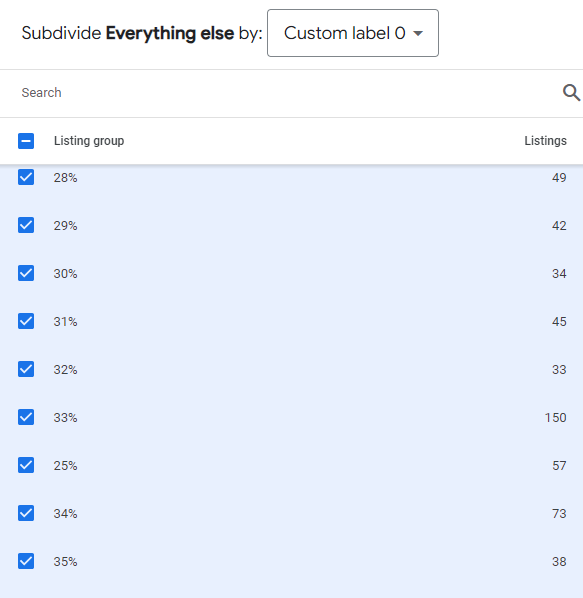
By employing this feature within the feed, you can hone in on focus areas. This will save you time on manual segmentation, as well as giving you additional insights and aligning your marketing strategy with your business goals.
5. Feed Rules

Feed rules are a powerful tool to optimise your product feed quickly, without the need to have access to the raw feed. They give you the ability to manipulate and transform data within the feed, unlocking many new opportunities to enhance your product listings.
There are many different ways that you can use feed rules. The main ones enable you to change required data – if there is some missing or incorrectly formatted – add additional data to incorporate more variables, and also clean up the feed by removing redundant or irrelevant information.
Practical ways to use this could include, for example, temporarily appending “Black Friday Sale” to titles in November. You can also use the “Extract” feature to pull specific data out of titles/descriptions to fill in other attributes e.g. Colour or Size.
Feed rules empower you by enabling you to quickly change attributes in the feed to suit your needs. With the click of a button you can enhance your feed’s relevancy, visibility and the performance of your products to ultimately drive more traffic and conversions to your site.
These are just a few of the ways that you can improve your Google Shopping performance through optimising your product feed, giving your campaigns the best potential within the auctions. By leveraging these tools, you are able to start filling in the gaps and giving Google as much information as possible whilst also giving you more flexibility in your marketing efforts.
Anna Simpson is the Head Of Paid Media at Cedarwood Digital – a performance marketing agency based in Manchester.
PPC
Google Ads Releases New Search Partner Insights & Controls Following Advertiser Concerns

One of Google Ad’s top benefits is its massive reach. Advertisers can easily reach billions of people across the greater web through Google search, Shopping, Maps, Gmail, YouTube, Discover, and more than 2 million different partner websites and apps. Google makes it easy for advertisers to reach all of these constantly updating placements across the web, too. Some of Google’s campaign types–such as Performance Max, App, and Smart campaigns–even automatically target all of these available placements to further simplify reaching this massive audience for advertisers.
However, seasoned advertisers know that not all placements are equally valuable. In fact, your brand’s ad next to the wrong content can upset your customers, damage your brand, and work against your goals. It’s crucial to monitor where your ads appear online to prevent these missteps, but for years, advertisers couldn’t view or control some of their ad placements on Google, specifically in their search partner network.
However, after some recent vocal concerns from brands, Google has responded and released a new tool for some advertisers to review their ad placements across the search partner network and exclude placements that may be inappropriate.
Contents
What is the Google Ads Search Partner network?
Believe it or not, Google isn’t the only search engine across the web! There are hundreds of smaller search engines and millions of websites with search bars–and many of them serve similar PPC ads within their search results. However, most of these smaller sites don’t build their own advertising platforms, such as Google Ads or Microsoft Advertising. Instead, they partner with Google (or Microsoft) to help advertisers connect with searches on their sites. These secondary search engines across the web make up the Search Partner network and collectively make up a decent share of search traffic for many industries.
🚨 Ready to learn how to maximize your campaign success across networks? Start with our free Google Ads Grader!
Google’s Search Network is comprised of two main components:
- Google search sites, which include Google Search, Google Shopping, Google Images, and Google Maps.
- Search Partner network includes YouTube search, smaller partner engines, and sites that host a search bar powered by Google. A surprising number of local and specialty websites are part of the Search Network–including some recognizable tertiary search engines like Ask.com.
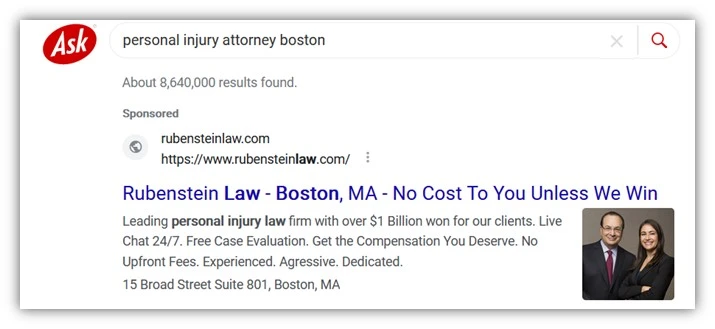
In Google Ads, advertisers can easily view their search campaigns’ results and segment their performance between Google search and the Search Partner network. Within search campaigns, advertisers can easily opt out of the Search Network at any time within their campaigns’ settings.


However, Google’s Performance Max campaigns don’t offer that visibility or flexibility to advertisers. Google’s Performance Max (and other fully automated campaign types) dynamically places your ads across the entire Google network (Google search, search partners, display, YouTube, video, discover, and Gmail) to dynamically use AI to maximize your campaign’s results.
The problems with Google’s Search Partner Network
Google’s Search Partner network’s additional reach is generally positive for advertisers–but that reach comes at additional costs and concerns. Even if most search partners on the network are from reputable, high-quality sites, the vast internet unfortunately hosts many low-quality sites and bad agents.
Google has never previously shared a list or directory of its ever-changing search partners. And unlike placements across the Google Display Network, advertisers haven’t been able to review where their ads appeared on the Search Network. Search advertisers had the choice to buy ads on the entire Search Partner network–or opt out entirely. Advertisers using Performance Max campaigns were automatically included across the entire Google network, including Search Partners.
Over the years, advertisers have become increasingly worried and vocal about the kinds of content their ads appeared alongside, and many advertisers have serious concerns about their brand image across the web.
Recently, Adalytics published a study revealing some concerning placements across the search partner network and discovered that several large companies, agencies, and government agencies were allegedly paying to show ads across some very questionable sites. Some of the examples from their study include pornographic content, pirated content, and sites that may be subject to international sanctions.
Google largely refuted the claims from Adalytics and assured advertisers that ad revenue wasn’t being shared with sanctioned entities. They further asserted that Adalytics claims were exaggerated and that such sites “represent a minuscule amount of [Google’s] Search Partner network.”
Shortly afterward, Google announced it would temporarily allow advertisers to opt out of the Search Partner network in Performance Max and App campaigns until March 1. Advertisers would have to contact Google directly to opt out of Search Partners in these campaigns.
Google’s new Performance Max campaign placement report
Addressing advertiser’s growing concerns, Google announced that it would begin to share more insights into where advertisers’ ads appeared across the web, including on the Search Partner network. Starting on March 4, advertisers can review how frequently their ads appeared across individual placements within their Performance Max and App campaigns.
The report is now available to all advertisers with active Performance Max and App campaigns. However, the reporting is slightly hidden from how advertisers generally review their search queries or other ad placements. Instead, advertisers can find these two new reports within the “report editor” section of the Google Ads dashboard.


The new Performance Max campaign placement report shows where and how often your Performance Max ads appeared on different placements from the web. Unfortunately, the report only shows the ad impressions from your Performance Max campaigns–other performance metrics, such as clicks, costs, and conversions, are unavailable.
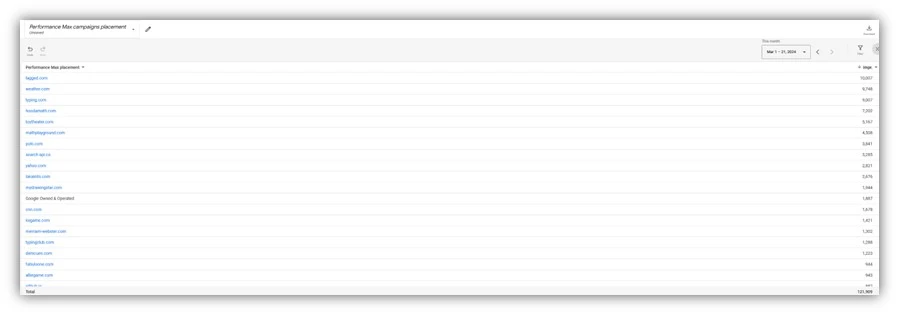

This reporting is only available for Performance Max and App campaigns. Traditional search and shopping campaigns still do not have any reporting available for individual placements across the search partner network.
🛠️ Set your Google Ads campaigns up for success with our free guide to the perfect Google Ads account structure!
How to opt out of Google search partner placements
Starting in March, Google will also allow advertisers to exclude individual Search Partner placements from showing ads for any campaigns in their account, including Performance Max. The placement exclusion can only be added at the account level–unlike many other placement exclusions, which are available at the campaign or ad group level.
To exclude a placement from showing your ads, you will need to create a placement exclusion list and apply it to your account. The Placement exclusion lists are kept under the “Tools and Settings” menu in Google Ads, under the “Shared Library.”
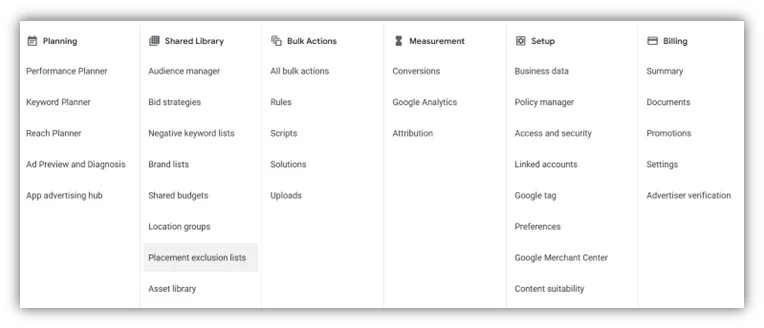

Once you create a new exclusion list, it will automatically be added to all of your campaigns in that account. New placement exclusions may take up to 12 hours to go into effect.
Take control over where your brand shows online
Google’s newest placement reports and exclusion options are designed to give advertisers more visibility into where their ads appear across the web and more control over their brand online. How much you decide to use these controls is up to you, but it’s always a best practice to review your placements and add new exclusions regularly.
Want more like this? How to Use Google’s New Brand Restrictions to Gain Back Control of Your Spend
PPC
5 Campaign Red Flags And Why They Matter

As PPC experts, we rarely have the luxury of harnessing 100% of our efforts and energy into a single account. When we do, it’s usually substantial, with multiple markets, products, and budgets to consider.
With a plethora of metrics to learn and utilize, optimizing our campaigns can feel overwhelming. Over the years, I’ve narrowed the optimization tasks down to focus on five key metrics and red flags. This will allow you to execute fast and effective boosts to campaign performance and efficiencies.
Here are 5 red flags to look out for on your PPC campaigns and, crucially, how to fix them.
1. A Weak Clickthrough Rate
We all know the importance of CTR (click-through rate) as a metric. It serves as a strong indicator of relevance between our keywords, our ads, and the user’s search terms. While the go-to benchmark used to be 2-3%, the introduction of automated bidding strategies and RSAs has moved this closer to 5-6% in most industries.
A CTR below this level raises considerable red flags. Not only does it indicate weak ad group relevancy, but it’s inefficient; the ‘Expected CTR’ of your ad has an effect on your ad rank, and bid, and will see you falling short at auction time.
Here are two simple, yet effective, fixes for a weak CTR:
Take your Assets Reports – a breakdown of the effectiveness of each headline and description – and start by swapping those ranked ‘Poor’ or ‘Average’ to new alternatives on your ads.
The second simple step is to review your ad groups. Over time, your ad groups and your keyword list are both likely to have expanded. Are there any opportunities to separate top-performing keywords from the rest? Do your keywords fit one neat theme, or are multiple themes creeping in? If so, separate them and tailor each ad’s copy to the new themes.
2. Missing or incomplete campaign settings
Back to basics. As someone who has audited 100s of accounts, time and time again I see the same handful of issues. By now, we’re all surely aware of the sneaky default location setting of ‘People interested in your targeted locations’ over ‘People in your targeted locations’. (If not, double-check your campaigns to ensure they’re serving where your target audience is!). There are, however, a few more settings worth checking on, and language settings are one of these.
On Google, language targeting matches queries “where the keywords match and Google believe that the user understands at least one targeted language”. On Microsoft Ads, the language campaign setting “determines the language that you will use when you write your ads and should be the language of your customers”.
Whether or not your brand has a global reach, your ad copy within each campaign is unlikely to be in all languages (often the default setting). When serving an international audience, best practice is to create unique campaigns and ad copy native to the respective local languages. Regional nuance is critical too.
Check your Campaign Settings to ensure that the language of your ad copy matches the audience(s) you’re asking your PPC platform to reach.
3. A lack of exclusions
If you’re running your accounts at peak efficiency, you should have plenty of exclusions in place. With the push towards upgrading your keywords to broad match, performance max black boxes, and a substantial rise in automation techniques, we PPC heroes need to be more on top of exclusions than previously.
Whether you’re running search, performance max, video, or display campaigns, exclusions are likely to apply to your campaigns.
Such exclusions include:
- Negative keywords
- Audience exclusions
- Content suitability, placement, or topic exclusions
- Brand exclusion lists
- Location or country-level exclusions.
If you don’t currently have exclusions applied to your campaigns, that could mean inefficient campaigns: targeting the wrong keywords, showing ads to current customer lists, on irrelevant or harmful content, on competitor content, or even in the wrong country entirely!
As a simple first step, begin by applying negative keywords to your account, campaigns, and/or ad groups and review your basic audience targeting options. If you can exclude current customers, reduce your demographic targeting from 18-65+, and double-check your campaign targeting and exclusion settings, that’s a great start.
4. Sub-par quality scores
One of the easiest ways to create inefficiencies is by failing to monitor quality scores. According to Google Ads, quality score is “a diagnostic tool meant to give you a sense of how well your ad quality compares to other advertisers”. This score is from 1-10, (1 being poor, 10 being excellent), is available at the keyword level, and is a product of the following three factors ranked from “below average” to “average” and “above average”.
- Expected CTR: Based on historical data, how likely is it that your ad will be clicked?
- Ad rank: How closely does your ad match the user’s search query and the intent behind it?
- Landing page experience: How useful is your landing page? Does it answer or support the user’s search query?
Luckily for those of us who struggle with math, the platforms calculate these for us based on the last 90 days of auction insights. In a perfect world, we’d aim for a quality score of 10 – although that may not always be possible. However, 7 or above is indicative of a ‘good’ quality score, with 3 or below being poor.
As with other items mentioned in this list, weak quality scores contribute to inefficient campaigns. To address this, work on optimizing each of the above three factors, starting with any that are ranked “below average”. Remember: the ultimate goal is to ensure that your keywords, ad copy, and landing pages are consistent in content.
5. No conversion data
And finally, one of the biggest red flags is a lack of conversion data. Generating zero conversions is one thing – and may be a red flag, but having no conversion data at all is concerning.
Today, PPC platforms are much stronger – particularly on brand-new accounts – on encouraging conversion setups before creating or publishing a campaign. However, there are plenty of legacy accounts with old, incomplete, or out-of-date conversion tracking, likely leading to millions of dollars in wasted spend annually. If you’ve been putting off the dreaded conversion tracking setup process, don’t delay further.
The final tip here is to ensure your conversion tracking is up to today’s standards. While conversion tracking for the end-goal of your campaigns is undeniably important, you’ll also want to track ‘lighter’ conversion events to give your PPC platform all the signals it needs to generate conversions – particularly when using smart bidding strategies.
If you’re using Maximize Conversions, Target CPA, Target ROAS, or Maximize Conversion Value smart bidding strategies and you have multiple conversion methods tracked (such as app downloads, phone calls, lead form fills, and product page views), ensure that each conversion is set up as a ‘Primary’ or ‘Secondary’ conversion goal respective to how important it is. Multiple primary conversion goals will make it difficult to optimize your campaigns.
Summary
Whether you’re brand new to PPC or have decades of experience, frequent platform changes often mean adapting what you thought you already knew! The five tips above should give you a great starting point for optimizing, improving, and boosting the efficiency and effectiveness of your accounts. Good luck!
-

 MARKETING5 days ago
MARKETING5 days ago18 Events and Conferences for Black Entrepreneurs in 2024
-

 MARKETING6 days ago
MARKETING6 days agoIAB Podcast Upfront highlights rebounding audiences and increased innovation
-

 SEO6 days ago
SEO6 days agoWhy Google Can’t Tell You About Every Ranking Drop
-

 PPC6 days ago
PPC6 days agoGoogle Ads Benchmarks 2024: New Trends & Insights for Key Industries
-

 SEO6 days ago
SEO6 days agoHow To Use ChatGPT For Keyword Research
-

 PPC6 days ago
PPC6 days agoThe Ultimate Guide to Click Fraud
-

 PPC5 days ago
PPC5 days ago86 Summer-Ready June Content Ideas
-

 SEO6 days ago
SEO6 days ago56 Google Search Statistics to Bookmark for 2024








